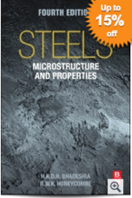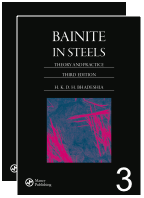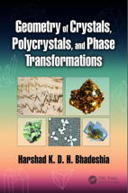
4th edition, 2017

Free download

Free download

Cementite is present in the vast majority of steels, in meteorites, possibly at the core of the Earth, and has uses in its pure form. It is now known that it can deviate from its strict stoichiometric ratio represented by the formula Fe3C, but not by much because the Fe-C bond contributes significantly to its cohesion. Its crystallographic unit cell is orthorhombic and primitive, with large lattice parameters when compared with those of iron, and therein lies the explanation for its hardness. Many of its properties are anisotropic and this has consequences when cementite is embedded in a matrix of other phases. Its single-crystal elastic properties have been investigated in depth using first principles calculations and by a few clever experiments on single crystals. The twelve iron atoms in the cell occupy two types of positions with different point symmetries, whereas the four carbon atoms lodge within prismatic interstices. The structure can develop defects such as dislocations, faults and vacancies. Cementite is metallic, its electrical resistance increases with temperature. It is ferromagnetic with a Curie temperature of about 187°C. It can be alloyed, usually by substituting metallic solutes on to the iron sites, or by replacing the carbon atoms with boron. These and many other aspects of cementite are reviewed here, with the contents focusing on the carbide as a single phase in isolation.
International Materials Reviews 65 (2020) 1-27 https://doi.org/10.1080/09506608.2018.1560984
Alternative site to download paper
Papers and information on cementite.
 4th edition, 2017 |
 Free download |
 Free download |
| PT Group Home | Materials Algorithms |